Top 10 Evergreen Shrubs
Evergreen shrubs provide permanent structure in the garden and all-year-round interest. Some have beautiful flower displays or are highly scented in winter when little else is growing, and some have variegated or colourful foliage which is a perfect foil for summer perennials and a feature in itself during the winter. Grow evergreen shrubs as stand-alone specimens, as part of a mixed border or as hedging.
There are plenty of evergreen shrubs to choose from but if you need some inspiration take a look at our pick of top ten evergreen shrubs for an easy and reliable display.
1. Daphne
Daphne plants are well loved for their small but incredibly fragrant flowers which appear in winter and early spring, when little else in the garden is growing. There are both plain-leaved and variegated varieties available, such as Daphne odora ‘Aureomarginata’, which has a rounded compact habit and attractive glossy, yellow-edged leaves. Daphne is fairly slow-growing making it a superb small evergreen shrub for the garden. Grow Daphne in sunny or partially-shaded mixed borders, woodland gardens and rock gardens. Daphne laureola and Daphne pontica are excellent for difficult, heavily shaded areas of the garden.

2. Box
Box (Buxus) is a compact and versatile evergreen shrub. Box plants are superb for clipping into a small, formal hedge which can be used to edge vegetable or flower beds, or try creating your own elaborate box parterre! Being tolerant of deep shade, it’s great for awkward sunless spots or for growing beneath tall trees. Box can also be used for topiary, either in the ground or grown in patio containers. Grow box in a well-drained soil in partial or full shade. Keep the soil moist if growing box in full sun to prevent the leaves from scorching. Other similar shrubs which can be grown to the same effect include Lonicera nitida, Taxus baccata 'Semperaurea' or Ilex crenata.
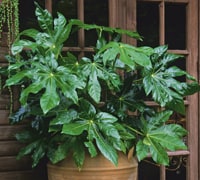
3. Fatsia
Fatsia japonica is a versatile shrub with large, glossy hand-shaped leaves borne on stout, upright stems. This exotic-looking shrub is surprisingly hardy and copes well with coastal conditions and tricky shady areas of the garden. Large stems of creamy white flowers, arranged in spherical umbels are produced in the autumn, which are attractive to bees and a great source of late season nectar. Fatsia plants are very architectural and can be grown in borders or large patio containers as an eye-catching feature.
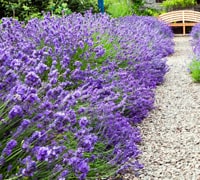
4. Lavender
A well-loved shrub grown for its fragrant summer flowers and scented silver-green foliage. Flowering in shades of purple, lilac or pink, this hardy shrub is so versatile; from edging to hedging and borders to patio containers - every garden should have lavender! The flowers are highly attractive to bees and butterflies and thanks to their Mediterranean origins, lavender plants have good drought tolerance, coping well with light, sandy soils. Use the silvery foliage as a contrast to dark foliage plants and try cutting some lavender flowers for a vase indoors, or to sprinkle on top of cakes!
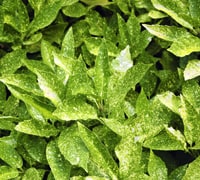
5. Aucuba
One of the toughest shrubs out there! Aucubas are popular evergreen shrubs valued for their tolerance of full shade, dry soils, pollution and salty coastal conditions. Although plain-leaved varieties are available, the speckled yellow cultivars are the most popular and give rise to the common name ‘Spotted Laurel’. The leaves are generally quite large, to 20cm (8") long, leathery and glossy in appearance making them useful for achieving a tropical look in the garden. Female plants will produce bright red berries in autumn if a male pollination partner is planted nearby. Grow Aucuba as specimen plants, for hedges or in difficult heavily-shaded corners of the garden. They will even grow well in large patio containers making a fine contrast or foil to other foliage plants and flowers.

6. Camellia
A classic spring-flowering shrub originating from the woodlands of Asia. Camellias are popular for their glossy deep green foliage and abundance of large, showy flowers early in the year. Camellia flowers can be single or double and come in a wide range of colours from pink to red, through to yellow or white. Although naturally large shrubs, dwarf varieties are available and Camellias tolerate hard pruning well so can easily be controlled if outgrowing their allotted space. They are elegant shrubs, ideal for mixed planting schemes or as specimen shrubs in borders and woodland gardens where they will receive partial or dappled shade. They require an acid soil so if your soil is neutral or alkaline grow Camellias in large patio containers filled with a mixture of ericaceous compost and a soil-based compost such as John Innes No. 3.
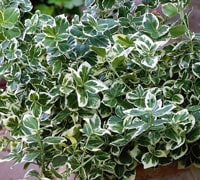
7. Euonymus
Cultivars of Euonymus fortunei are versatile, low-maintenance, evergreen shrubs with a multitude of uses and a tolerance of poor soils, coastal conditions and shade. Thanks to its prostrate habit these Euonymus plants can be grown as evergreen ground cover or trained to climb a wall - they tolerate north-facing walls well. They can also be grown as hedges or free standing shrubs in garden borders and patio containers. With a variety of foliage colours available from green to variegated white or gold, Euonymus fortunei cultivars are fantastic for adding winter colour to the garden.

8. Mahonia
Mahonia plants have an architectural form and glossy, spiny leaves, similar to holly. They are valued for their late winter and spring flowers which are bright yellow and highly fragrant. Mahonia flowers are borne on long, elegant racemes or in clusters at the tips of branches, creating a distinctive and striking display when much of the garden is still dormant. They are also a fantastic early source of pollen and nectar for bees. Coping well with coastal conditions, clay soils and heavy shade Mahonia makes an unbeatable, low-maintenance addition to shrub borders and woodland gardens. Some species and cultivars have a low-growing habit and can be used as groundcover.
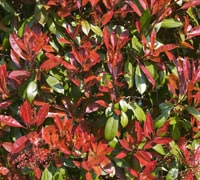
9. Photinia
Photinias are tough, versatile shrubs, the most popular variety being Photinia x fraseri ‘Red Robin’, whose glossy leaves are bright red when young, gradually changing to bronze-green through to deep green. Photinias light up shrub borders in the spring and make a good foil for summer-flowering plants. Grow Photinias in sunny borders, as specimen shrubs in large patio containers, or as hedging, for which Photinia x fraseri is ideal.

10. Holly
A well-known evergreen shrub, with glossy, dark green leaves, which can be either spiny or smooth. Although best known for its classic dark green leaves and red berries at Christmas, there are many variegated forms of Holly which make outstanding specimen plants in the garden or planted as part of a mixed border. Holly plants also make a fantastic dense hedge, for which Ilex aquifolium and Ilex x altaclerensis are the best species to use. The spring flowers are highly attractive to bees and are followed by red or yellow berries on female holly bushes, if a male pollination partner is planted nearby. The berries are a good winter food source for birds. Tolerant of coastal conditions and partial shade, this tough shrub deserves a place in every garden.
